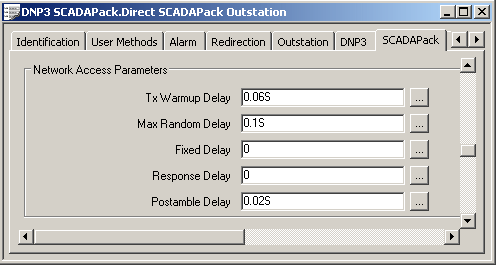For multi-drop networks, the SCADAPack E outstation can perform ‘media collision avoidance’, whereby transmissions are checked for collisions with another transmission on the network. If a collision is detected, the outstation re-attempts the transmission, after a delay. The Modes that support collision avoidance are:
- RS232 (RTS Keyed)
- FSK Radio (only available on Port 3 on 386 eNET outstations)
- FSK Landline (only available on Port 3 on 386 eNET outstations).
Use the fields within the Network Access Parameters section of the SCADAPack tab to define the operational characteristics when a SCADAPack E outstation uses a multi-dropped network, such as a radio network. Specify each value in the OPC Time Format.

- Tx Warmup Delay—Specify the delay that is required between the transmission media being activated and the actual transmission of data. This delay allows the transmission device (for example, a radio unit) to activate its transmitter.
- Max Random Delay—Specify the maximum additional delay that the outstation adds to the Fixed Delay, before sending data on the transmission media, once the outstation has detected a transmission collision. The outstation will add a random delay of any length up to and including this value.
- Fixed Delay—Specify the fixed time delay for which the outstation waits, before attempting a data transmission, once it has detected a transmission collision. Before the transmission is attempted, the outstation adds an additional random delay (see Max Random Delay above).
NOTE: If both the Fixed Delay and Max Random Delay are set to zero, the SCADAPack E outstation does not perform any collision avoidance.
- Response Delay—Specify the period for which the outstation is to delay transmission of any data prior to activating the transmission device. A delay other than zero may be required where a radio repeater is slow to drop its carrier and the outstation tries to respond too quickly to a request to send data.
- Postamble Delay—Specify the amount of time that has to elapse between the last byte being sent and the Request to Sent (RTS) signal being turned off.